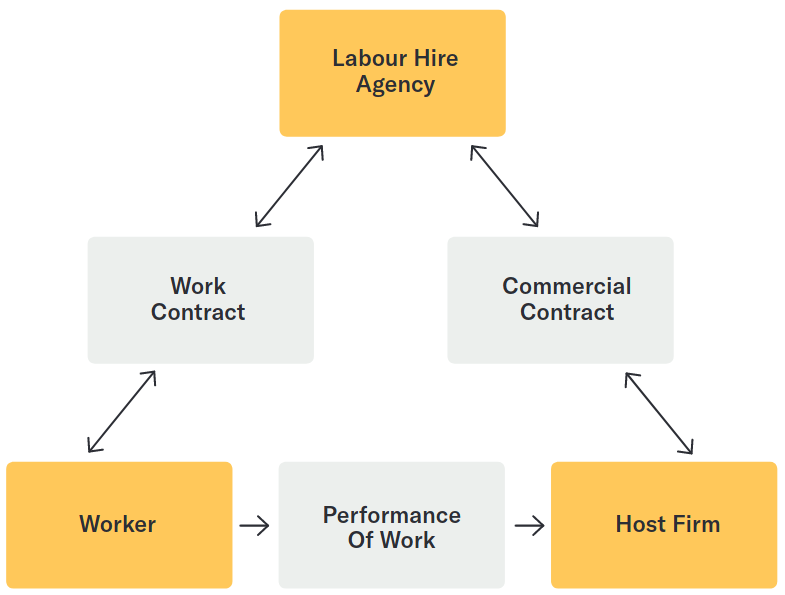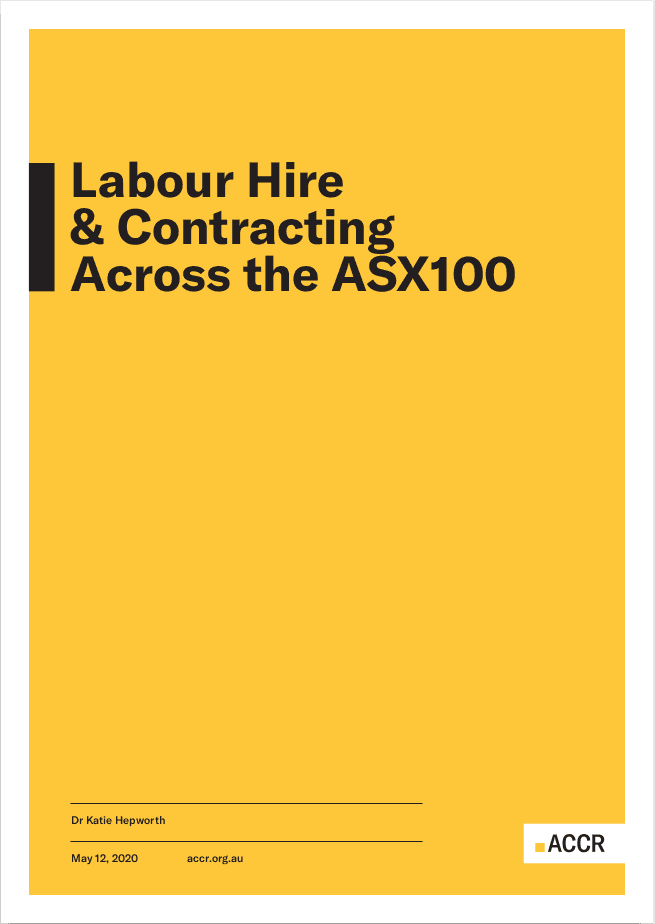Publication Labour Hire & Contracting Across the ASX100: 1. Background: Labour Hire in Australia
What is Labour Hire?
Labour hire is broadly defined as a “triangular employment arrangement”, involving three parties: a worker supplying labour; a host company or entity; and an intermediary, such as a labour hire agency (see Figure 1).
In the ‘standard’ form of this arrangement, the host company contracts an intermediary labour hire agency to provide them with labour. The labour hire agency then contracts a worker to provide that labour and is responsible for paying the worker.
Fundamentally, labour hire arrangements split contractual and control relationships: the labour hire worker has a direct contractual relationship with the labour hire agency, but it is the host company who oversees their day-to-day work. The introduction of sub-contracting arrangements can further complicate these contractual and control relationships.
There are considerable variations in the contractual and control relationships that are broadly defined as labour hire, including:
- Labour hire workers filling short term vacancies for a host
- Labour hire workers performing seasonal work for a host on a short-term basis
- Labour hire workers performing long term work for a host, alongside permanent direct employees of the host
- The staffing of a host’s entire business, or a specific business unit, with labour hire workers
- A host contracting out a particular business function (e.g. maintenance) to a labour hire agency[1]
Each of these employment arrangements represents diverse risks to the company, and may have different impacts on the host company’s long-term value. Investors engaging companies on their use of labour hire must seek to understand the types of employment arrangements used by a company, and their potential impact on a company’s overall value creation.
FIGURE 1. Standard labour hire arrangement

Contemporary Labour Hire Arrangements in Australia
Triangular or intermediary working arrangements are not a recent innovation and have existed since at least the 1950s.[2] However, the use of labour hire has grown rapidly since the 1990s. This growth has been accompanied by a transformation of the role of labour hire employment in the labour market, from a model that predominantly involved the use of “short term, supplementary or ‘top up’ labour” to one that “increasingly takes in a variety of work arrangements which may extend through to longer-term supplementation of the workforce or substitution of permanent workers”.[3]
There are a number of reasons why employers may choose to use labour hire workers: to reduce costs, to adapt to volatile labour markets, for specialisation, to undermine or circumvent union presence, to avoid employer obligations, to exert greater control over a workforce, or to shift risks and liabilities away from an employer.[4]
The contemporary labour hire industry includes many different types of labour hire agencies, spanning from large, multinational corporations with thousands of staff (e.g. CIMIC), through medium-sized and mid-tier labour hire providers, to operators consisting of an individual (or a few individuals) “with a van and mobile phone”.[5] Different types of labour hire agencies are often specific to individual sectors and represent a diverse range of risks to host companies and investors.
The Extent of Labour Hire in Australia
It is difficult to ascertain the exact size of the labour hire workforce in Australia. Researchers argue that existing datasets may significantly under-report numbers of labour hire workers in Australia for various reasons, including confusion on the part of labour hire workers regarding their employment relationship, and whether they are “being paid by a labour hire firm or the organisation they are on-hired to”.[6]
The use of labour hire varies considerably between different sectors. According to ABS 2019 data, the sectors with the highest proportion of non-employees (both independent contractors and other business operators) were agriculture, forestry and fishing (56%) and construction (39%), while the sectors with the highest percentage of independent contractors were construction (27%), administration and support services (17%) and professional, scientific and technical services (14%).[7]
Furthermore, particular types of labour hire arrangements are more prevalent in particular sectors. For example, the Queensland Mining Inspectorate (QMI) reports that 50% of the QLD mining workforce are labour hire, with some mining operations being staffed almost entirely by labour hire workers (see Section Four).
Department of Premier and Cabinet, Inquiry into the Labour Hire Industry and Insecure Work (2015—2016), Melbourne, Victorian Department of Premier and Cabinet, 2016, p. 52 [accessed 6 April 2020]. ↩︎
R Hall, Labour Hire in Australia: Motivation, Dynamics and Prospects, Sydney, University of Sydney, April 2002, p. 4. ↩︎
Inquiry into the Practices of the Labour Hire Industry in Queensland, Brisbane, Queensland Government, 2016, p. 9 [accessed 6 April 2020]. ↩︎
Hall. ↩︎
Department of Premier and Cabinet, p. 52. ↩︎
G Gilfillan, Trends in Use of Non-standard Forms of Employment, Canberra, Parliament of Australia, 18 December 2018; see also Hall. ↩︎
ABS, ‘6333.0—Characteristics of Employment, Australia, August 2019, Table 10 Form of employment by industry, occupation and educational qualification’,
ABS, 2019 [accessed 19 December 2019]. ↩︎
